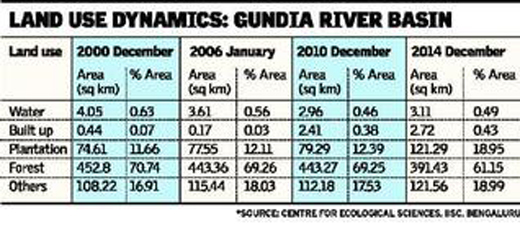Forest cover in Gundia river catchment down by 10 p.c.: report
Forest cover in Gundia river catchment down by 10 p.c.: report
Mangalore Today News Network
Mangaluru, Sep 19, 2015 : Area under forests in the Gundia river catchment in the Western Ghats has reduced from 70.74 per cent to 61.15 per cent in the last one-and-half decade, according to a recent report from the Indian Institute of Science (IISc), Bengaluru. The Yettinahole is a tributary of the Gundia.

The report titled “Environmental Flow Assessment in Yettinahole. Where is 24 tmcft to divert?” has also pointed out that water yielding area in the Gundia river catchment has shrunk from 0.63 per cent to 0.46 per cent during the same period.
Contrary to the claims of some political leaders that the Yettinahole diversion project is not meant to divert the Netravati river, the report from the Energy and Wetlands Research Group, the Centre for Ecological Sciences at the institute, points out that the Yettinahole finally joins the Netravati through the Gundia river.
The report said that the Yettinahole is one of the perennial water sources in the Western Ghats.
It said: “Yettinahole, originating at an altitude of 950 m in Sakleshpur taluk of Hassan district, is a tributary of the Gundia (which joins the Kumaradhara) and finally drains into the Netravati.”
It said that the Gundia is formed by two streams — the Yettinaholé and the Kempuholé. Then, Gundia is joined by two more streams — the Kadumaneholé and the Hongadahalla — to form a river course. The Gundia catchment region is surrounded by the Hemavathi river watershed on its right, the Barapole river catchment on its left and the Netravati in the downstream.
The report, released in April, said that the area under forests in the Gundia river catchment has been reduced by 61.37 sq km that is from 452.80 sq km in December 2000 to 391.43 sq km in December 2014.
Water yielding area has shrunk by 0.94 sq km, from 4.05 sq km to 3.11 sq km, during the same period. At the same time, the report pointed out that the area under plantation went up by 46.68 sq km in area, from 11.66 per cent (74.61 sq km in area) to 18.95 per cent (121.29 sq km in area).
It said that a sustainable option to meet the water requirements of arid regions is through decentralised water harvesting (through tanks, ponds, lakes, etc.), rejuvenation or restoration of existing lakes/ponds, recharging groundwater resources, planting native species of herbs and plants in the catchment, and implementation of soil and water conservation through micro-watershed approaches.
Courtesy :The Hindu
- BSF Denies Reports of Bangladeshi Murder Suspects Entering India via Meghalaya Border
- Youth, Innovation and Values Key as PM Modi Delivers Final Mann Ki Baat of 2025
- BJP Alleges Contradiction in Gruha Lakshmi Scheme, Slams Excise Push
- Congress Divided Over Digvijaya Singh’s Remarks on BJP-RSS
- Big ’Op Aaghat’ crackdown in Delhi, hundreds arrested before New Year
- Home-alone nurse murdered in Bengaluru, police arrest lover
- CBI moves SC against bail to Sengar in Unnao rape case; protests continue
- DGCA panel concludes probe into IndiGo disruption, submits report to Aviation Ministry
- Punjab boy, 10, gets Bal Puraskar for serving soldiers during Op Sindoor
- Vaibhav Suryavanshi honoured with highest civilian award, set to meet PM Modi
- BJP makes history in Kerala, gets 1st ever mayor in big pre-poll boost
- Chitradurga accident: Death toll rises to 7 as bus driver succumbs to injuries
- Fire at Puja Item Shop in Kundapura Damages Five Shops
- New Speed Record Set at Mangaluru Kambala, Surpassing Srinivasa Gowda’s Feat
- Karnataka Coast Gears Up for New Year; Heavy Crowds at Temples and Beaches, Traffic Swells
- Diocese of Mangalore Concludes Jubilee Year of Hope 2025
- Kambala Is Identity of Tulunadu, Not Just a Rural Sport: B Y Vijayendra
- Ahmed Kabeer - A ’Stephen Hawking’ in Kudla
- Diocese of Mangalore Condemns Attacks on Christians During Christmas, Seeks Government Action
- KSRTC to procure 900 new buses; Mangaluru, Udupi to get priority allotment
- 11-year-old girl injured in alleged moral policing incident near Mangaluru; two booked
- Ninth Mangaluru Kambala inaugurated in presence of Mary Kom
- Sullia: Young woman dies of brain Haemorrhage; mother donates organs in remarkable act of humanity
- Kasargod: Man dies after being hit by train at railway station
- Kadaba: Bar employee booked for misappropriating cash, liquor stock worth over Rs 6.57 lakh
- Mangaluru Student Goes Missing; Ullal Police Register Case
- APD Foundation Joins WHO Civil Society Commission
- Daiva’s prediction comes true: Janardhan Reddy walks free from jail
- Skills and Competencies Take Center Stage at MSN Dialogue Series
- Court remands Maoist Lakshmi to six-day police custody
- Sandhya Shenoy honored with Society for Materials Chemistry Medal-2024
- White Cornus Apartment in Mangaluru
- City girl wins first place in state-level spell bee competition
- Alleged ‘Love Jihad’ Case in Mangaluru: Woman left home voluntarily, says police
- Girl fatally struck by reckless two-wheeler near Belman
- New residential complex for the judges inaugurated in Mangaluru
- Absconding accused nabbed after 8 years
- Truck with cylinders turns turtle in Beltangady
- Bhoota Kola artist dies of cardiac arrest
- Development of the country should be our goal: Ganesh Karnik
- CITY INFORMATION
- TRAVEL
- TOURIST INFORMATION
- HEALTH CARE
- MISCELLANEOUS




 Write Comment
Write Comment E-Mail
E-Mail Facebook
Facebook Twitter
Twitter  Print
Print 

